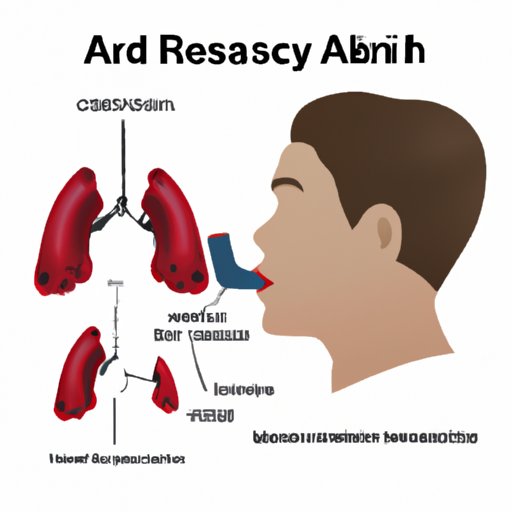
Understanding Reactive Airway Disease: The Causes, Symptoms, and Treatment Options You Need to Know
Reactive Airway Disease (RAD) is a term used to describe a variety of respiratory conditions characterized by temporary narrowing or inflammation of the airways. This narrowing can make it difficult to breathe properly, leading to coughing, wheezing, and shortness of breath. In this article, we will explore the causes, symptoms, and treatment options for RAD, as well as how to manage it on a daily basis.
What Is Reactive Airway Disease And Why Is It Important To Understand?
Reactive Airway Disease is a general term used to describe any condition that causes temporary constriction or inflammation of the airways, including asthma and bronchitis. Understanding this condition is important because it can be a symptom of more serious respiratory problems, like chronic obstructive pulmonary disease (COPD) or lung cancer. Additionally, proper diagnosis and treatment of RAD can improve your quality of life and prevent long-term complications.
Understanding the Symptoms, Causes, and Treatment Options for Reactive Airway Disease
Symptoms of RAD can vary depending on the underlying condition causing it. Some common symptoms include:
- Chest tightness
- Shortness of breath
- Wheezing, whistling or squeaking sound when breathing
- Coughing, especially at night or in response to allergens and irritants
- Trouble breathing during exercise
The causes of RAD can also vary, but the most common triggers are:
- Environmental allergens, like dust, pollution or pollen
- Viral infections, such as colds and flu
- Exposure to irritants, like smoke or chemical fumes
- Physical activity or exercise
There are several treatment options available for RAD, including:
- Inhaled corticosteroids to reduce inflammation in the airways
- Short-acting bronchodilators to relax the muscles around the airways and improve breathing
- Long-acting bronchodilators to improve symptoms and prevent flare-ups
- Leukotriene modifiers to reduce inflammation and mucus production in the airways
- Immunomodulators to protect against allergens and other environmental triggers
Living with Reactive Airway Disease: Tips for Managing Your Symptoms
There are several strategies you can use to manage your symptoms and improve your quality of life while living with RAD:
- Avoid smoking or exposure to secondhand smoke
- Avoid exposure to environmental allergens and irritants
- Exercise regularly to strengthen the muscles used for breathing
- Get plenty of rest and manage stressors effectively
- Take your medications as prescribed and keep your inhaler with you at all times
- Monitor your symptoms and seek medical attention if they worsen or do not improve with treatment
Asthma vs Reactive Airway Disease: What’s the Difference?
One of the most common respiratory conditions often confused with RAD is asthma. While both conditions share many similarities, there are some significant differences between them.
Asthma is a chronic respiratory condition characterized by airway inflammation, constriction, and mucus production that is usually present over a longer period of time. Conversely, RAD is generally a temporary condition caused by specific triggers and is usually more responsive to immediate treatment.
To properly diagnose and treat each condition, it is essential to consult a healthcare professional and undergo breathing tests as needed.
The Link Between Allergies and Reactive Airway Disease
Allergies, particularly those affecting the respiratory system, have been shown to play a significant role in the development of RAD. Several studies have shown that those with allergies are more likely to develop RAD, and that the severity of symptoms is often linked to allergy severity as well.
To manage allergies effectively, it’s important to identify allergens that trigger them and work with a healthcare provider to develop a plan to avoid or manage those allergens. This may include medications, immunotherapy, or other treatment strategies as needed.
Reactive Airway Disease in Children: Signs, Diagnosis, and Care
Children can develop RAD, and the condition can often be mistaken for other respiratory problems like asthma or bronchitis. Common signs and symptoms in children include:
- Coughing, especially at night or in response to allergens and irritants
- Shortness of breath
- Wheezing or noisy breathing
- Chest tightness or pain
- Fatigue and irritability
Diagnosis and treatment typically involve similar strategies used for adults, including breathing tests, allergy testing, and medication management. It’s essential to work closely with a healthcare provider to monitor the condition in children and adjust treatment as needed.
Conclusion
Reactive Airway Disease can cause significant discomfort and impairment in daily life. However, with proper management techniques, it’s possible to live a healthy, fulfilling life. Be sure to consult with a healthcare provider to identify the underlying cause of RAD and develop a personalized treatment plan. Always monitor your symptoms and seek medical attention if they do not improve or worsen, and take steps to avoid environmental triggers as much as possible.





